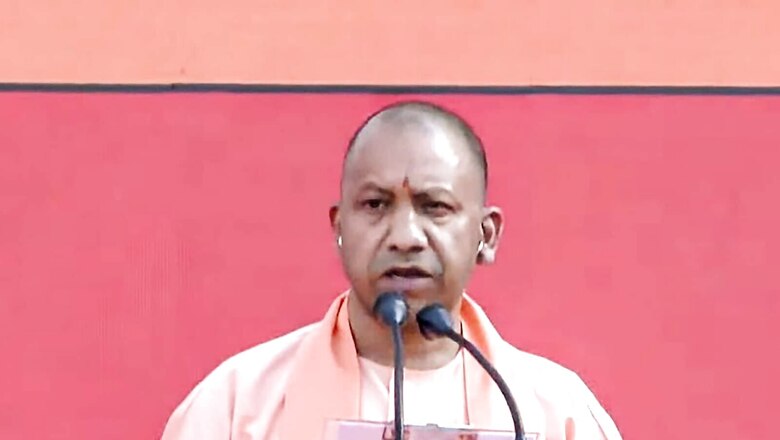
views
The elemental substratum of any society is education, and it is the principal obligation of any government to creatively and constructively serve to formulate a sustainable education system for the society. Education enlightens human intellect and is foundational for achieving comprehensive and inclusive human potential. It plays an apropos role in auguring an equitable and virtuous society complimenting proselytising national development.
The Uttar Pradesh government’s central theme has been facilitating universal access to excellent and quality education, which can lead to the holistic development of an individual vis-à-vis society. Chief Minister Yogi Adityanath has relentlessly been working to transform and revamp the state’s educational structure. The immediate policy attention in the state has been on ensuring that the dropout rate falls and the enrollment rate is maximised. The state is taking every initiative to bloom as many flowers as possible, keeping late Prime Minister Atal Bihari Vajpayee’s policy of ‘Sarva Shiksha Abhiyan’ as the cardinal motto.
Under the Yogi regime, the status of education infrastructure and facilities has tremendously improved, addressing the growing developmental imperatives of the country. With the quickly changing landscape, the Uttar Pradesh government has emphasised the development of students’ foundational and cognitive capacities with its two-pronged strategy. First, availability and accessibility of schools regardless of socio-economic background to improve the enrollment ratio and revamp access to the hinterlands. The second strategy is to focus on the qualitative and substantive aspects of education by inculcating quality education based on robust output. On both scales, Uttar Pradesh has improved during the Yogi government.
The practical implementation of the first strategy can be traced through the Annual Status of Education Report (ASER), which records the increasing trend in the student enrollment ratio in the state, specifically in rural areas. According to the report, the enrollment of children between the age of 6 to 14 in Uttar Pradesh was 43.1 percent in 2018, which exponentially improved to 56.3 percent in 2021. If one observes the changes in the enrollment percentage in various states between 2018 and 2021, Uttar Pradesh seems to be on the upper echelons in the education sector, marking a push of 13.2 percent, which is more than the national advancement of 6.1 percent. The girl’s enrollment ratio in 2021 improved to 58.1 percent from 51.9 percent, and boys from 47.8 percent to 54.8 percent in the same year. UP’s education measures and literacy rate have increased from 67.68 percent in 2011 to 81.8 percent and 73.0 percent in males and females, respectively, in 2022. One can also see an increase in the percentile of women’s literacy rate of 9.6 percent in 2022 from that of 2021.
The state government not only focused on improving the enrollment rate of the children amidst the pandemic but also ensured that students were equipped with textbooks. The government’s reform in the education system is evident from the escalating percentage of students who have textbooks in UP increased from 79.6 percent in 2020 to 91.3 percent in both the public and the private schools.
The strategy of focusing on the qualitative aspect can be seen in the experimental study. In collaboration with Pratham, the state facilitated the “Graded Learning Programme” for the 8.4 million children studying in 113,000 government primary schools to improve the learning process. To strengthen the foundational skills, the students across grades 1-5 were grouped depending upon their reading and analytical skills, and then appropriate activities and materials were used to enhance their understanding of the subjects. As a result, 22 percent improvement in students’ reading ability could be traced after the launch of GLP. As an outcome, a 22 percent improvement in reading ability can be seen after the launch of GLP.
Under this strategy, the plan was to “significantly improve the learning levels in basic reading and arithmetic; introduce and sustain innovative teaching-learning practices in schools, and to build monitoring, mentoring and academic support capacity at block and district levels”. The Yogi government facilitated the GLP by providing technological amenities, other materials for classrooms and student training, and the managerial level of resource persons. The improvement of the teaching-learning was also contingent upon recruiting and monitoring the teachers.
The Uttar Pradesh government has curated 23 facilities, such as toilets, electricity, boundary walls, gates, and additional classrooms, under the Operation Kayakalp programme, covering 1.6 lakh schools. Under this initiative, 92,000 primary schools were renovated and equipped with infrastructure and basic amenities such as textbooks, school dress, and other stationary items. The programme ensured basic methods of quality control and accountability for the overall development of the students.
The advent of the Covid-19 pandemic resulted in the “Prerna Sarathi Campaign”, launched by the UP government to upgrade the accessibility of the online mode of education. The aim was to improve the reach of the online mode of education. The government further announced the distribution of 2.5 lakh tablets and 5 lakh smartphones. The UP government also launched “Abhyudaya Yojana”, under which free coaching and consultation for poor students of the state were provided. Other schemes like “Samarth” and “Sharda” were also launched and implemented to streamline the divyang student’s education and to re-enroll the students to the school. To make the state digitally empowered, the provision for cashless payments to government school instructors and money for uniforms for kids via direct cash transfers have been introduced.
The state also witnessed a complete overhaul and re-energising of the higher education system with 12 new universities, 250 Inter level colleges, and 77 degree colleges. Apart from this, “one District, one Medical college” was also launched, under which all 75 districts will have one medical college.
The fundamental improvement in the education sector under the Yogi government is the outcome of sustained efforts, mainly by the government and some under the PPP model. The Yogi government is trying to revamp the erstwhile lacklustre status of public education in the state. The government’s vision, specifically in the education arena, is meant to educate young minds by apprehending, enhancing, and fostering the unique capabilities of each student.
The state government has taken different measures to transform the state into a knowledge society to make education more approachable, holistic, learner-centric, and experiential. The Indian knowledge system has also been proposed to cover traditional notions of Vastu Shastra and Astrology. Apart from this, keeping in mind the psychological stress a child goes through, each institute is instructed to set up a career counselling institute to ensure physical, academic, psychological, and emotional well-being. The state-level ranking structure of educational institutes with an internship programme for students in classes 9 to 11 has also been in the pipeline. To fulfill the need of the hour and promote digital empowerment, a proposal for WIFI accessibility in all schools for teachers from all fields has been put on the table for clinching.
The state is trying to bridge the gap between learning and outcomes by undertaking major reforms that bring the highest quality, equity, and integrity into the system, from early childhood education to higher education. It has incorporated technology in teaching and learning methods and educational planning and management to leverage its potential completely. The government is further making systematized arrangements to support students from different cognitive domains to contrive career progression, recruitment, and advancement.
The UP education model is a case study for the rest of the world to learn how a gigantic state with a substantial population can manage resources efficiently to create a silent revolution in the education sector. The systemic and institutional transition starting from the grassroots to the urban centre has been an unprecedented achievement and what is more credible is the monitoring mechanism which is periodically reviewed by the CM himself. The UP education model is the beginning of an equitable, effective, and efficient arrangement between the government and citizens where affordability, accessibility, and accountability precedes all.
The writer is the founder of the House of Political Empowerment [HoPE] Research and Innovation Foundation, based in New Delhi. He is a KASYP fellow and research scholar at the University of Delhi. He tweets at @DigvijayHoPE. Views expressed are personal.
Read all the Latest Opinion News and Breaking News here



















Comments
0 comment